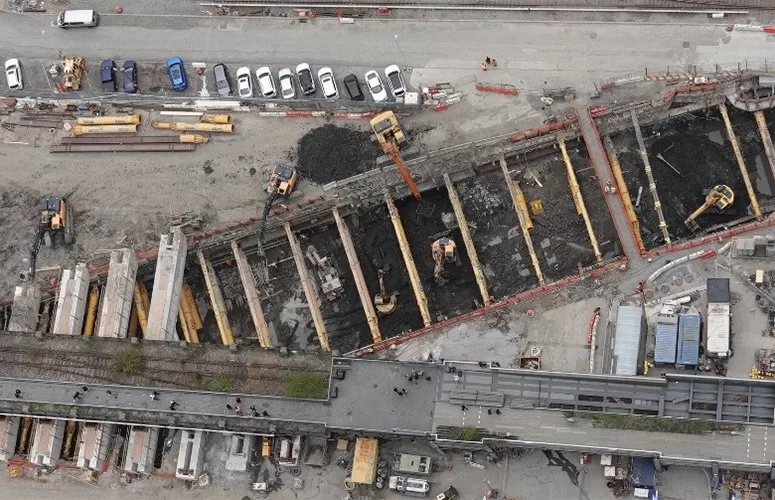The Hudson Tunnel Project reaches a milestone as construction of the Hudson Yards Concrete Casing surpasses halfway completion.
The Gateway Development Commission (GDC) announced today, May 20, 2025 that construction on the Hudson Yards Concrete Casing – Section 3 (HYCC-3) has surpassed the halfway mark, marking a key milestone for the broader Hudson Tunnel Project (HTP). This segment, which will provide the essential connection between the new Hudson River rail tunnel and New York Penn Station, is progressing on schedule and within budget, with full completion expected by 2026.
The HYCC-3 section is the final piece in a series of concrete casings designed to protect and support the new tunnel infrastructure. Stretching approximately 500 feet in length, 60 feet wide, and 60 feet deep, the structure is built from heavily reinforced concrete, with walls ranging from 3.5 to 10 feet thick and surrounded by a waterproof membrane.
This milestone represents a critical advance in one of the nation’s most urgent mass transit infrastructure projects. Which aims to replace the aging, 115-year-old tunnel between New Jersey and New York. The Hudson Tunnel Project is a centerpiece of efforts to modernize rail service along the Northeast Corridor, enhancing reliability and capacity for tens of thousands of daily commuters.
HYCC-3 Jobs, Cost
Construction of HYCC-3 currently supports 4,820 jobs and contributes nearly $1 billion to economic output. The overall Hudson Tunnel Project is projected to generate 95,000 jobs and stimulate $19.6 billion in economic activity, underscoring its significant impact on the regional economy.
Amtrak, serving as construction manager on the HYCC-3 project, emphasized the importance of the milestone. Amtrak President Roger Harris stated, “This milestone is a testament to the hard work and collaboration among our partners. It brings us closer to delivering a vital piece of infrastructure that will support the region’s growth for decades to come.”
Read also: Greenbacker Begins Construction on New York’s Largest Solar Farm
Currently, five of the ten projects that constitute the Hudson Tunnel Project are in progress
Other key construction efforts within the Hudson Tunnel Project are advancing alongside HYCC-3. The Tonnelle Avenue Bridge and Utility Relocation Project, which will enable the launch of tunnel boring machines by providing critical highway access, is over 75% complete and on track for a 2025 finish.
Meanwhile, the Hudson River Ground Stabilization Project involves injecting concrete into the riverbed on the Manhattan side to create a reinforced foundation sturdy enough for the tunnel boring machines to safely pass through.
Early work on the Palisades Tunnel Project, the first tunnel boring segment of the HTP, is underway with monitoring equipment installations and geotechnical surveys in progress, while production of tunnel boring machines is underway with tunneling set to begin in 2026.
Manhattan Tunnel Project began construction this spring. The contract was awarded in February. It will connect to Hudson Yards casing. It will provide machine removal access. Five of ten Hudson Tunnel Projects are now active. GDC plans to award two more contracts in 2026.
The broader economic benefits
Regional Plan Association’s report shows Gateway Program’s substantial economic impact. The new trans-Hudson rail tunnel will generate $445 billion in total economic activity. Construction will produce $42.8 billion. Long-term regional benefits will reach $230 billion.
As work continues, the HYCC-3 milestone serves as a tangible sign of progress toward transforming one of the country’s most critical transportation corridors.
Read also: Hudson River rail tunnel project in New York, USA
Hudson Tunnel Project Reaches New Milestone: HYCC-3 Specifications
Length: ~500 feet
Width: 60 feet
Depth: 60 feet
Construction: Heavily reinforced concrete with walls 3.5-10 feet thick
Protection: Complete waterproof membrane system
Timeline: On schedule for 2026 completion
Budget Status: Within allocated budget
Related Hudson Tunnel Projects Progress
Tonnelle Avenue Bridge & Utility Relocation: 75% complete, targeted 2025 finish
Hudson River Ground Stabilization: Concrete injection underway to reinforce riverbed
Palisades Tunnel Project: Preliminary work and tunnel boring machine production in progress
Manhattan Tunnel Project: Construction commenced Spring 2025
Economic Impact
HYCC-3 Direct Impact: 4,820 jobs; ~$1 billion economic output
Total HTP Projected Impact: 95,000 jobs; $19.6 billion economic activity
Long-term Regional Benefit: $230 billion (per Regional Plan Association)
Total Gateway Program Economic Activity: $445 billion (construction + operation)
Read also:GDC Awards $1.18 Billion Contract for Manhattan Tunnel, a Segment of the Hudson Tunnel Project (HTP)

